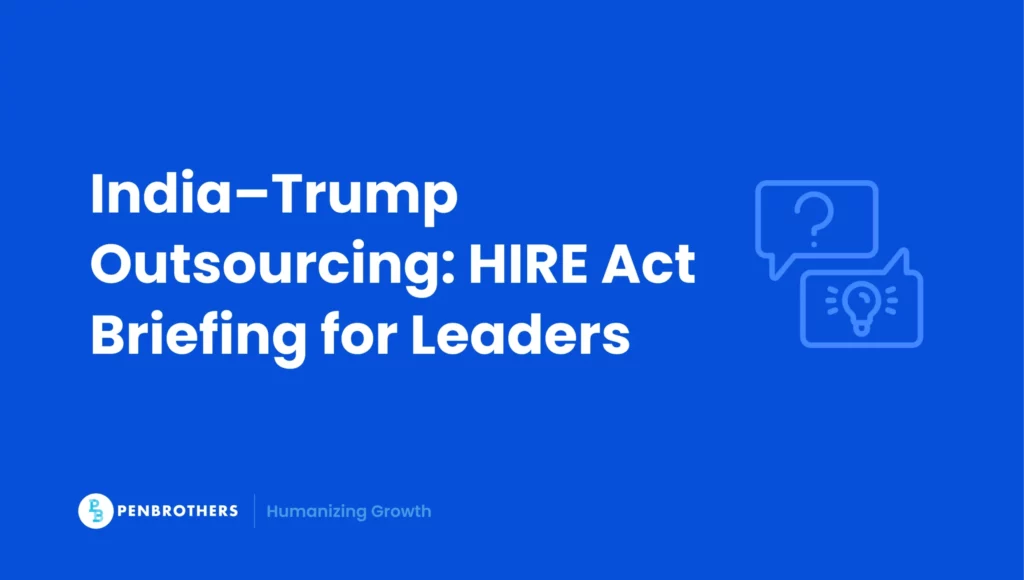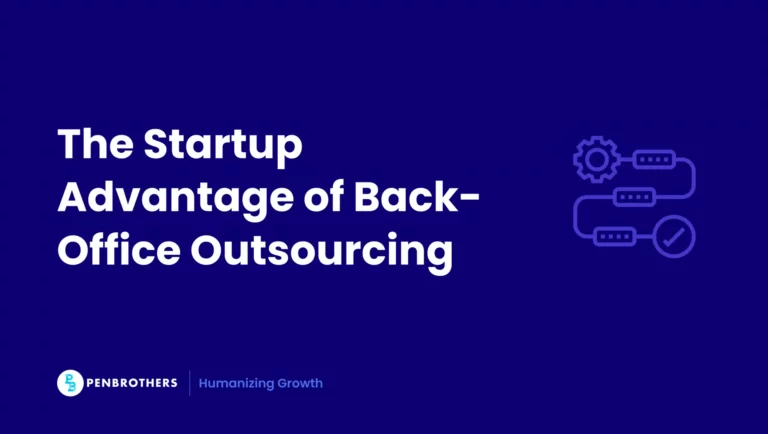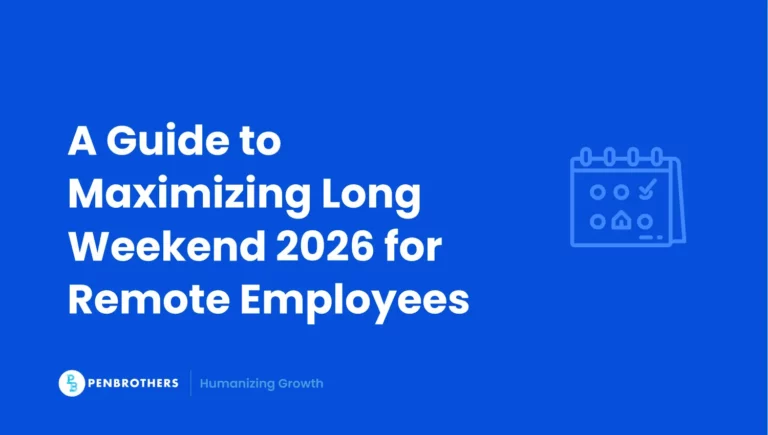In the first week of September 2025, Senator Bernie Moreno announced his intent to introduce the Halting International Relocation of Employment (HIRE) Act. The bill was formally introduced in the Senate as S. 2976 on October 6, 2025, and referred to the Committee on Finance. It proposes a 25% excise tax on outsourcing payments made by U.S. companies to foreign service providers and would remove the tax deductibility of those expenses.
The bill is introduced, not law.
At the same time, activist Laura Loomer claimed President Trump is considering blocking U.S. tech companies from outsourcing to India, a claim that is unconfirmed. For U.S. business executives tracking, the questions are immediate: what is in force, what could change deal math for 2026, and what actions to take now.
This briefing separates statute from rumor around Trump’s outsourcing policies, then lays out timelines, cost models, contract language, and next steps.
Key Takeaways
- HIRE Act is Stalled but Not Dead: The proposed HIRE Act (S. 2976), which would impose a 25% excise tax on outsourcing payments and remove their tax deductibility, has been introduced in the Senate. However, as of late November 2025, it is currently stalled in the Senate Finance Committee with zero co-sponsors, signaling that it lacks urgent bipartisan support and is unlikely to advance quickly in its current form.
- No Official Ban on Outsourcing: Despite widespread rumors and social media claims, there is no official ban on outsourcing to India or any other country. The administration has not issued any executive orders to this effect; the discussion is centered on legislative proposals like the HIRE Act, not executive action.
- The Proposed Tax Would Affect All Offshore Locations: The HIRE Act is not country-specific. Its language targets payments to any “foreign person” for services benefiting U.S. consumers, meaning it would impact outsourcing to all global destinations, including the Philippines, India, and Latin America.
- Immediate Action: Monitor and Prepare, Don’t Panic: While the bill’s momentum has slowed, the legislative text remains active. U.S. businesses should use this reprieve to monitor committee activity and prepare by reviewing vendor contracts for “change-in-law” clauses, rather than making drastic changes based on stalled legislation.
The Facts: HIRE Act, What Is Actually on Paper
HIRE Act, in Plain English
- Creates a 25% excise tax on outsourcing payments, defined as money paid by a U.S. person to a foreign person for services that benefit U.S. consumers
- Denies tax deductibility of those outsourcing payments
- Directs revenue to a Domestic Workforce Fund for apprenticeships and training
- Applies prospectively, the draft and coverage point to payments after Dec 31, 2025
What Counts As “Outsourcing Payments” vs Normal Cross‑Border Ops
This isn’t just about your typical Bangalore call center contract. The bill’s language sweeps wide:
- Third‑party vendors in India and other countries
- GCCs and captives, intracompany services that benefit U.S. consumers
- Freelancers and marketplaces paid abroad for services used by U.S. customers
Yes, this means your Global Capability Center in Hyderabad and that freelance developer in Mumbai both potentially fall under the same tax umbrella.
What Is Not Confirmed or in Force
Let’s be clear about what’s noise versus signal:
- The HIRE Act has been introduced in the Senate and referred to the Senate Finance Committee.
- As of November 2025, the bill remains stalled in the Senate Finance Committee with zero co-sponsors. Industry analysts now view the legislation as unlikely to advance in its current form, describing it as ‘political signaling’ rather than imminent policy. However, the legislative text remains active, meaning the risk persists even if momentum has slowed.
- The legislative process is deliberate. A bill’s introduction is the first step, not the last. Its movement in and out of committee is the signal to watch.
- There is no official ban on outsourcing to India or any other country. The administration has not issued an executive order on the matter. What exists is a single, proposed bill.
The administration hasn’t issued an executive order. Congress hasn’t passed anything. What we have is one senator’s bill and a lot of political theater.
“Trump India Outsourcing”: Signals Versus Rumors
On‑Record Signals That Shape Policy Direction
White House messages emphasize “American workers first”, workforce training, and reshoring, so this bill is consistent with the current administration’s thinking.
“President Trump is reportedly considering blocking U.S. tech companies from outsourcing jobs to India.”
This claim originated in activist Laura Loomer’s posts and was widely reported. Key word: claim. It is not confirmed by any official statement or document.
Loomer said on X: “President Trump is now considering blocking US IT companies from outsourcing their work to Indian companies… Make Call Centers American Again!” She followed up with: “I am so excited for President Trump to end the days of pressing 2 for English to speak with someone who doesn’t speak English.”
The problem with treating this as gospel? Loomer holds no official position. The White House hasn’t confirmed her assertion. This is speculation that got picked up and amplified by media outlets looking for a story.
Timeline: What Happened and When
Let me walk you through the sequence that got us here:
- Late Aug 2025: U.S.-India trade tensions remain a key backdrop following stalled bilateral trade negotiations.
- Sep 5, 2025: Senator Moreno first announces his plan to introduce the HIRE Act, creating the initial wave of media coverage.
- Sep 5–7, 2025: Activist Laura Loomer claims a potential outsourcing ban, which remains unconfirmed speculation.
- Sep 8–10, 2025: Indian and global outlets summarize potential impacts and contract risks. The market started responding to uncertainty.
- Sep 17, 2025: In a significant procedural move, Senator Moreno attempts to pass the bill via “unanimous consent” on the Senate floor. The attempt is blocked, ensuring the bill must go through the standard committee process.
- Oct 6, 2025: The HIRE Act is formally introduced as S. 2976 and referred to the Senate Finance Committee. Nov 20, 2025: Reports from FICCI and global trade analysts indicate that the rollout of President Trump’s broader tariff agenda has been ‘slower than anticipated,’ granting businesses a reprieve. The HIRE Act specifically has seen no movement or committee hearings since its introduction, signaling a lack of urgent bipartisan support. This indicates it faces a standard, uphill committee battle, not an accelerated path to law.
What matters about this timeline? The tariffs happened fast. The bill introduction was deliberate. The ban talk was speculative, but was treated as news.
Related articles:
- Outsourcing to India and the HIRE Act: What U.S. Companies Should Do Now
- Outsourcing Tax: What Is Official, What Is Proposed, What Is Noise
- Fed Rate Cuts and Outsourcing in 2025: Executive Guide
- The H-1B Visa $100K Fee: Policy Details and Industry Reactions
- The U.S. Government Shutdown Is a Wake-Up Call for Offshore Resilience
Who Is Exposed, and How
U.S. buyers
If you’re running procurement for a U.S. company, here’s the problem:
- Cost exposure: a 25% excise with no deduction lifts effective spend by about 50 to 60% depending on tax profile
- Contract risk: re‑pricing pressure, change‑in‑law triggers, governance uplift, and attestations
- Operating model: push to onshore or nearshore certain roles, accelerated automation
The cost increase isn’t just the 25% tax. You lose the tax deduction, too. So a $100 outsourcing payment that currently costs you about $79 after tax savings would cost $125 under the HIRE Act—a 58% jump.
Indian IT Providers and GCCs
The exposure here is massive:
- Revenue concentration: more than 50 to 60% of export revenue tied to U.S. clients
- Margin compression: buyers will negotiate tax‑inclusive pricing or deeper discounts
- Delivery mix shifts: more high‑value work, selective onshore pods, diversified geographies
When Rohit Jain at Singhania & Co. law firm analyzed this, he noted: “This could impact new contract acquisitions, affect profit margins, and compel Indian IT companies to seek growth opportunities in markets beyond the United States.”
Scenario Planning: Three Plausible Paths
Optimistic: narrowed scope and slower rollout
- Tighter definitions, carve‑outs for certain functions, longer transition windows
This would look like the bill getting watered down in committee. Maybe a lower tax rate. Maybe exemptions for critical services. Maybe a three-year phase-in instead of immediate implementation.
Base case: prolonged uncertainty
- Bill stalls in committee, rhetoric continues, contracts add tax‑sharing clauses, and shorter terms
This is probably the most likely scenario in the near term. The bill exists, which creates planning uncertainty. Companies hedge by adding change-in-law clauses to new contracts. Everyone waits to see if it gains momentum.
Pessimistic: hardline implementation
- Full 25% excise applies broadly, no deduction, strict anti‑abuse rules, heavy attestations
In this scenario, the bill passes largely as written. The tax applies to everything the language covers. Compliance becomes a major operational burden.
Diagnostics to watch
Monitor committee calendars, new co-sponsors, and any official White House statements. The most significant signal to date emerged on October 16, 2025, when Charter Communications became the first major U.S. corporation to publicly endorse the HIRE Act, stating it “recognizes the value of a high quality, onshored workforce.” Corporate endorsements are a new, critical diagnostic to track.
Why Is So Much Outsourcing Sent to India?
U.S. companies have historically prioritized India for outsourcing, building a multi-decade, $200+ billion industry. This dominance is not accidental; it rests on three distinct pillars.
1. The Cost Arbitrage
The primary driver remains a significant labor cost differential. A U.S.-based software developer and an Indian counterpart may have comparable skills, but their salary expectations are vastly different due to the lower cost of living in India. This arbitrage allows U.S. companies to reduce operational expenses, with many firms reporting savings of 60% or more on equivalent salaries.
2. The Talent Pool
India possesses an unmatched scale of human capital. It has a developer workforce estimated at over 5.4 million professionals and produces millions of STEM (Science, Technology, Engineering, and Mathematics) graduates annually. This creates a massive, accessible talent pool, including a large English-speaking population, which is critical for business communication.
3. The Mature Ecosystem
Unlike many emerging destinations, India’s outsourcing industry is deeply mature. It is supported by established industry bodies (like NASSCOM), a large number of vendors with decades of experience, and a robust legal and infrastructure framework built specifically to service Western clients.
What Are the Problems with Outsourcing to India?
Despite its advantages, the traditional outsourcing model in India presents persistent, well-documented challenges. Business leaders must actively manage these risks.
1. High Employee Attrition
The Indian IT market is intensely competitive. This leads to high employee turnover (attrition) as skilled professionals frequently change jobs for better offers. While rates have stabilized from their 2022 highs of 25-30%, average attrition in 2024-2025 remains between 13-17%. For a U.S. company, this means constant retraining, loss of project-specific knowledge, and inconsistent team stability.
2. Hidden Costs and Poor Transparency
Many businesses are drawn in by low hourly rates, only to face “cost creep” from non-transparent vendors. These hidden fees can include charges for recruitment, IT infrastructure, office space, and administrative overhead that were not clearly defined in the contract.
3. Quality Gaps and Communication Mismatches
A common failure point is a simple misalignment of expectations. Time zone differences (India is typically 9-12 hours ahead of the U.S.) can hinder real-time collaboration. Furthermore, cultural differences in communication—such as a reluctance to deliver “bad news” directly—can mask project issues until they become critical, leading to expensive rework and missed deadlines.
Beyond India: What This Means for Global Outsourcing
The Ripple Effect
The HIRE Act doesn’t target India specifically. It applies to all foreign service providers. That means the Philippines, Eastern Europe, Latin America, and every other outsourcing destination face the same potential 25% tax.
Market data suggests the Philippines is emerging as a strategic hedge. A November 2025 analysis by real estate consultancy Colliers projects that the Philippine BPO sector may actually benefit from Trump’s protectionist policies. As U.S. companies face rising domestic production costs due to tariffs on imported goods, they are accelerating the outsourcing of non-core support functions to maintain profitability. The Philippines, with its cultural affinity and cost-efficiency, is positioned to capture this displaced demand.
Philippine Positioning
The Philippines has built its outsourcing strength on different foundations than India. Where India dominated through scale and cost arbitrage, the Philippines carved out leadership in customer service, creative services, and operational support. The country’s English proficiency and cultural alignment with Western business practices created competitive advantages beyond pure labor costs.
If cost becomes less of a differentiator—because everyone faces the same tax—other factors matter more. Time zone compatibility with the U.S. West Coast. Cultural fit. Service quality. Process maturity. These become the new battlegrounds.
An Unbiased Assessment
Companies like Penbrothers need to be realistic about what this means. If the HIRE Act passes, our clients will face higher costs regardless of where they source talent. Some will absorb those costs. Others will reduce offshore footprints. Still others will accelerate automation to offset labor expenses.
The businesses that survive and thrive will be those that help clients navigate this new reality rather than pretending it doesn’t exist. That means evolving from “cheaper offshore talent” to “strategic offshore partnerships that deliver value even when costs rise.”
What This Changes
The global outsourcing industry has operated for decades on the principle that labor arbitrage drives demand. Take away some of that arbitrage through taxation, and you force the industry to mature. The vendors that succeed will be those offering genuine operational advantages: better processes, stronger governance, higher-value services, and measurable business impact.
That’s not necessarily bad for destinations like the Philippines that have already invested in moving up the value chain. But it does mean the days of competing primarily on hourly rates are ending faster than anyone expected.
Action Playbooks
For U.S. Buyers: Next 30–60 Days
Here’s what smart procurement teams are doing right now:
- Contract addenda: change‑in‑law, pricing gross‑up or tax‑inclusive options, termination‑for‑convenience review
- Rate cards: re‑tier to reflect potential excise, split onshore versus offshore bands
- Dual‑shore pilots: shift a slice of workload onshore or nearshore to validate economics
- Automation offsets: fund RPA and gen‑AI to lower labor intensity
- Compliance readiness: service‑location reporting, officer attestations, vendor certifications
The key is not to panic, but to prepare. You want options if the landscape changes quickly.
For Indian IT Providers
Smart firms are already moving on this:
- Price architecture: table both net and tax‑inclusive bids, structure gain‑share for automation
- Service mix: lean into higher‑value work where price sensitivity is lower
- Geo diversification: expand APAC, EU, Middle East, selective onshore pods in U.S.
- Risk sharing: add tax‑contingency clauses and re‑opener language in MSAs
As Jaspreet Singh from Grant Thornton put it: “If enacted, this legislation may pressure US enterprises to reconsider offshore delivery models and prompt Indian service providers to recalibrate their global strategies.”
For GCC Leaders
The captive center question is tricky because the bill treats intracompany payments the same as third-party contracts:
- Intracompany charging: validate whether intercompany service flows could be in scope
- Scope ring‑fencing: separate U.S. benefiting activity from the rest where possible
- Controls: implement service‑location logs, periodic internal audit, attestations
Cost Modeling: What a 25% Excise Could Do
Illustrative example: $5,000,000 annual application maintenance deal
| Scenario | Cash Paid | Deductible | Effective Tax Impact | Effective Cost to Buyer |
| Today: offshore delivery | $5,000,000 | Yes | Corporate tax shield applies | ~$3,950,000–$4,150,000 equivalent |
| HIRE Act: as written | $6,250,000 | No | 25% excise, no deduction | ~$6,250,000 equivalent |
| Hybrid: 60% offshore, 40% onshore | Mixed | Partial | Excise only on offshore share | ~$5,250,000–$5,600,000 |
This model represents a fundamental shift in the economics of global delivery.
Contract Language and Governance
Clauses to revisit now:
- Change in law: define tax‑sharing, pass‑through, or re‑opener
- Gross‑up and tax‑inclusive pricing options
- Termination for convenience: step‑in rights, service mix triggers
- Reporting warranties: service location and subcontracting disclosure, audit rights
“Blocking” Risk and Data Flows
If any restrictions emerge, ensure data residency, access, and continuity are protected in the contract stack. The last thing you want is to be caught in a situation where you can’t access your own data because of a policy change.
Procurement Checklist
Ask vendors to show: service location heatmap, tax‑inclusive rate card, automation roadmap, compliance controls. Make this part of your vendor qualification process now, not after something passes.
The “No Tax Breaks for Outsourcing Act” vs. The HIRE Act
A point of frequent confusion is the difference between the HIRE Act and another piece of proposed legislation, the “No Tax Breaks for Outsourcing Act.” They are separate bills with similar goals but different mechanics.
What the “No Tax Breaks for Outsourcing Act” Proposes
First introduced several years ago and reintroduced in subsequent sessions, this bill focuses on amending the U.S. tax code to disincentivize the relocation of U.S. jobs. Its primary mechanisms are:
- Denial of Tax Deductions: It would prevent companies from deducting expenses incurred from moving operations or jobs offshore.
- Taxing Foreign Profits: It aims to end the deferral of U.S. taxes on profits earned by American companies’ foreign subsidiaries.
Key Differences from the HIRE Act
The distinction is critical for strategic planning. The “No Tax Breaks for Outsourcing Act” targets the act of moving jobs, making it more expensive to relocate a factory or a business unit. The HIRE Act, in contrast, targets the ongoing operational payments for services rendered abroad, regardless of whether a U.S. job was eliminated.
- HIRE Act: Imposes a new 25% excise tax on payments for foreign services.
- No Tax Breaks Act: Removes existing tax benefits for companies that move jobs overseas.
In essence, one is a tax on invoices, the other is a penalty for relocation. The HIRE Act has a much broader and more immediate implication for the IT and BPO industries, which rely on a global service delivery model.
Is Outsourcing a Dying Concept?
Far from dying, outsourcing is evolving. The old ‘lift and shift’ model—where companies simply exported chaos to the cheapest bidder—is indeed fading. It is being replaced by strategic staff leasing and value-based partnerships.
In 2025, successful outsourcing is less about ‘arbitrage’ and more about ‘talent access.’ Companies like Penbrothers are seeing a shift toward Global Capability Centers (GCCs) and dedicated teams that function as true extensions of the onshore workforce, integrated through frameworks like Hypercare rather than treated as transactional vendors.
Sources and How We Keep This Fresh
We cite only primary or top‑tier secondary sources. We will refresh this page as new official actions occur.
The policy landscape is moving fast. The HIRE Act is real legislation that deserves serious analysis. The ban talk is unconfirmed but worth monitoring. The tariffs are already hitting.
What matters most? Track what’s official, prepare for what’s possible, and don’t let the noise drown out the signal.
If you need expert guidance on how to navigate the current volatility in U.S. outsourcing, send us a message.
Frequently Asked Questions
The HIRE Act (S. 2976) has been introduced in the U.S. Senate and referred to the Finance Committee. However, it is currently stalled with no co-sponsors and no scheduled hearings. Industry analysts view it more as political signaling than imminent policy, though it remains an active legislative proposal.
No. This claim originated from unconfirmed social media posts by activists and has not been confirmed by any official White House statement or executive order. There is currently no ban on outsourcing to India or any other nation.
If passed as written, the combination of a 25% excise tax and the elimination of the tax deduction for outsourcing expenses would raise the effective cost of outsourcing by approximately 58%.
No. The bill’s language is broad and covers “outsourcing payments” for any service provided by a foreign person that benefits U.S. consumers. This includes IT services, software development, back-office support, and captive centers (GCCs), not just call centers.
Given that the bill is stalled, companies should not panic but should remain vigilant. The best course of action is to continue monitoring the legislative status of S. 2976, review existing vendor contracts for potential tax liability clauses, and model the financial impact of a 58% cost increase as a worst-case scenario for strategic planning.
Updated November 24, 2025 | Next update pending official developments






